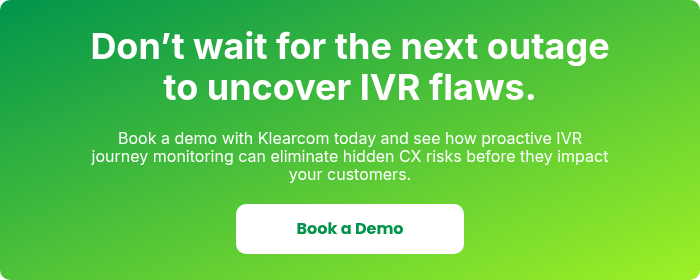 Klearcom
Klearcom
Interactive Voice Response (IVR) systems are designed to route calls efficiently, reduce wait times, and help customers solve problems quickly. But during peak traffic periods, such as Black Friday, tax season, or unexpected service outages, even the most well-designed IVR system can buckle under pressure.
The result? Laggy prompts, misrouted calls, confused voicebots, and a wave of frustrated customers who either zero-out to a live agent or hang up completely. These breakdowns don’t just create minor hiccups. They increase handling time, raise call abandonment rates, and quietly erode your contact center’s performance.
This post breaks down why IVR latency and IVR misrouting spike during high-volume events, how to catch these issues before customers do, and how proactive IVR journey monitoring can protect the customer experience at scale.
What Happens to IVRs Under Load?
When call volumes surge, the IVR system experiences the same strain as any overloaded digital system. You might not notice right away, but your customers do.
Callers can experience prompt delays. They press a key or speak a command, but the system takes several seconds to respond. That silence feels like a failure. Callers may think the system didn’t register their input, so they press again or start speaking over the system, creating a loop of confusion.
This is IVR latency in action. And it gets worse. Delays interfere with both touch tone (DTMF) testing and speech intent accuracy. If a caller says "Check bill payment" or presses 3 for support, a sluggish IVR might route them to the wrong menu. This kind of IVR misrouting confuses users and frustrates callers, especially when their intent is clear but the system can’t process it in time.
During peak hours, these errors multiply. Menus may not load properly. Bots struggle to understand fast-spoken commands. Routing rules break down under stress, sending customers to dead ends or back to the start. And when that happens, customer frustration skyrockets.
Many callers opt to zero-out to reach a live agent. Others simply abandon the call. Either way, your contact center faces rising costs and falling satisfaction.
Why You Often Don’t Know It’s Happening
You can’t fix what you can’t see. That’s the problem with IVR latency and misrouting.
These issues don’t occur evenly. They spike under pressure, at specific times of day, or in specific regions. One customer may reach the right menu instantly while another hits a loop or gets misdirected.
Internal QA teams often run static, scripted tests. But those tests don’t replicate the complexity of real-time customer interactions. They don’t simulate the journey of someone trying to make a bill payment from a mobile device in India at 9 p.m. local time. They won’t catch intermittent routing errors or measure prompt load time when your IVR is at capacity.
And speech-based IVRs add another layer. If your system relies on machine learning to handle voice commands, latency can break intent recognition. A delayed backend response means your voicebot hears a command, times out, then asks the customer to repeat themselves. That’s a quick way to frustrate callers.
These blind spots are exactly why proactive, always-on IVR journey monitoring matters.
How Journey Monitoring Works in Real Time
Klearcom’s IVR journey monitoring simulates full customer journeys across your IVR system. It performs DTMF testing and voice input across every menu path, validating both speech intent accuracy and system response time.
Unlike static QA, this testing happens continuously, across real devices and carrier networks in 100-plus countries. That means you can track exactly how your IVR performs under real-world conditions.
The platform measures response time in milliseconds, tracking whether prompts load promptly or stall. It follows call flows through every step, confirming that menu options route correctly, and that customers land in the right place every time.
For speech-enabled systems, it checks how accurately bots understand commands across accents, noise levels, and call types. Whether the caller is asking about account info or navigating service options, you get data on how well your IVR handles it.
You also get alerts. If "press 2 for sales" starts routing to the wrong team during high traffic, you’ll know immediately. If speech recognition fails after a certain time of day, that’s flagged too. This real-time visibility eliminates guesswork.
Journey Monitoring in Action
Imagine it’s the end of the month and your call center is flooded with billing inquiries. Customers call in to check balances, make payments, or update information. One caller presses 3 to access payment options, but the system lags.
Instead of getting to billing, they hear a support prompt. Frustrated, they hang up and call again, this time yelling into the phone hoping the bot gets it right. Eventually, they reach an agent, but the damage is done. That one misrouted call increased handling time, added cost, and left the customer with a poor impression.
Multiply that by a few thousand calls, and the consequences are serious.
Now imagine your system had flagged that behavior two hours earlier. Your team sees a dip in routing accuracy and a spike in zero-outs. You reroute traffic, reboot the affected node, and push a new prompt—all before customers start complaining.
That’s what proactive journey monitoring enables.
IVR Testing That Thinks Like a Caller
At Klearcom, our platform validates IVRs like a customer would. We don’t just check if a number connects. We test call flows end-to-end, from the first ring to the final transfer.
We simulate regional call volumes. We run touch tone inputs from different networks. We speak with local accents. We track how long each prompt takes to load. We validate menu options and check whether bots interpret speech correctly.
And we do all of this with zero integration required. You don’t need to modify your infrastructure or deploy code. Just give us your numbers. We’ll test them across 260 carriers and monitor them in real time.
This kind of outside-in validation ensures you’re not just testing functionality—you’re testing the full customer experience.
Stay Ahead of the IVR Curve
IVR latency and misrouting aren’t random glitches. They’re recurring, avoidable failures that weaken customer interactions and damage your contact center’s credibility. Left unchecked, they increase handling time, drive up call abandonment rates, and push customers toward your competitors.
By deploying real-time journey monitoring, you gain the insights needed to maintain consistent service—even during traffic spikes. You fix issues before they affect customers. You eliminate blind spots in IVR performance. And you ensure that no matter how busy things get, your customers reach the right destination with speed and clarity.


